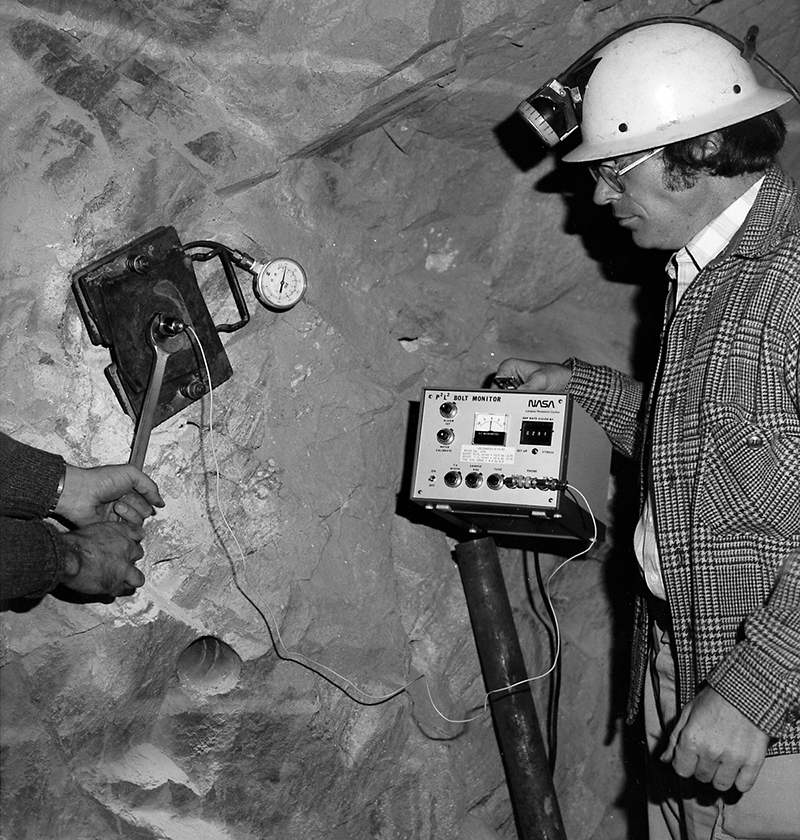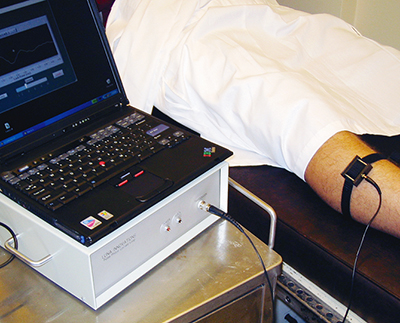
NASA’s Radio Frequency Bolt Monitor: A Lifetime of Spinoffs
Originating Technology/NASA Contribution
This story begins in the 1970s, when Dr. Joseph Heyman, a young scientist at NASA’s Langley Research Center, was asked to support the investigation of a wind tunnel accident at a sister center. Although the work was outside of his physics background, it sparked a research focus that guided his lengthy NASA career and would earn him a slew of accolades, including NASA’s highest award medals for Exceptional Leadership, Exceptional Achievement, and Exceptional Service; the coveted “Silver Snoopy” Astronaut Award for Space Shuttle Return to Flight; and the Arthur Fleming Award for being one of the Top Ten Federal Scientists in Government Service. He won 30 additional NASA awards, including the Agency’s “Invention of the Year” and the Agency’s highest award for technology transfer, and was the only person to ever win 4 R&D 100 Awards.
Back in 1973, though, Heyman was a young civil servant with a background in physics who was asked to sit on an accident review panel. The panel met at Ames Research Center, in Moffet Field, California, and after considerable investigation, concluded that a high-pressure pebble heater used for heating gas had failed, due to improperly tightened bolts in a 1,000-pound gate valve control section. The accident showered the facility with incendiary ceramic spheres and nearly a ton of metal, but, luckily, caused no injuries.
Heyman returned to Langley and began work on a solution. He developed an ultrasonic device that would measure bolt elongation, as opposed to torque, the factor typically measured in testing bolt preload or tension. Torque measurement can lead to load errors, with miscalculations as high as 80 percent that can be passed over during installation. Bolt stretch, however, is nearly always accurate to 1 percent or better.
Within 1 month, he had an acoustic resonance solution that accurately determined bolt elongation. He assumed his work on this project had ended, but it was actually the start of nearly 15 years of work perfecting, improving, inventing, and modifying the “bolt monitor”—all the while, filing numerous patents, presenting papers, and holding demonstrations as the technology matured.
Industry engineers challenged Heyman’s inventiveness, and reminded the physicist that most bolts are not perfect resonators, and that early devices required that the bolt have reasonably flat and parallel faces. The U.S. Geological Survey asked NASA for help in determining the load in mine roof bolts, which are 8- to 10-feet-long and rough cut. To solve that problem, Heyman modified the original device to operate at a lower frequency and to generate propagation modes that could be used to “lock” the instrument on a particular mode. Further work in this vein led to the development of the Pulsed Phase Locked Loop (P2L2) that worked on the mine bolts.
The next set of problems involved high-strength bolts with head markings. For this solution, Heyman invented a modified P2L2 that tracked a specific phase point in the measurement wave. This class of instrumentation, well suited to measuring small changes in acoustic velocity, won the NASA “Invention of the Year” award in 1982.
Other scientists and engineers have continued the evolution of this technology both inside NASA and outside of the Agency. Within NASA, the technology has been improved for medical applications, with a particular focus on intercranial pressure (ICP) monitoring.
Astronauts exposed to microgravity experience an elevation in ICP, which contributes to space adaptation syndrome, or “space sickness,” with symptoms similar to motion sickness on Earth, consisting of general discomfort, queasiness, nausea, vomiting, vertigo, headache, malaise, drowsiness, and lethargy. There is concern for astronauts developing ICP during long-duration missions, because experiencing these symptoms will not allow them to work to full capacity.
A second medical application, unrelated to space travel, involves muscle pressure that can build to a point where blood is unable to properly circulate, and leads to tissue damage and possibly death. This condition is called compartment syndrome. The compartments are groups of muscles surrounded by inelastic fascia, and thus, any swelling of muscles leaves no room for expansion. Blood supply is progressively cut off. Drs. Tom Yost and John Cantrell of Langley are working on applications that relieve the pressure using the P2L2.
Partnership
Heyman retired from the Agency in 2001, and he joined Nascent Technology Solutions, a small Virginia-based company in the field of nondestructive evaluation (NDE) that was recently purchased by Virginia neighbor, Luna Innovations, Inc. The scientists at Luna use diverse core technologies, including the P2L2 technology developed at Langley; so now, Luna is where Heyman continues his life’s work.
He is chief scientist for Luna and working with a new team to build a fully digital P2L2-equivalent device with broad applications ranging from medical to NDE.
Product Outcome
Luna has licensed rights from Langley to continue the work on studying compartment syndrome and ICP as well as found myriad uses for the P2L2 technology in the commercial realm.
Compartment syndrome is a significant cause for surgery among soldiers in Iraq. It stems from blunt trauma causing inflamed muscles, which then creates pressure, resulting in heart strain, as the organ is not getting the blood it needs. The result, if left untreated, may lead to amputation or death. The current treatment involves slicing into the muscle tissue to relieve pressure, which, in addition to being quite excruciating, creates a large wound with risk of infection and a painful recovery time.
The current measurement to determine if the surgery is necessary is a bioptic pressure plunger, another painful procedure involving extraction of tissue from the aggravated area.
With cooperation from NASA’s team, Luna’s Dr. Ted Lynch has advanced the commercialization of the P2L2 to alleviate the need for this procedure and prevent unneeded surgery. It is already in use in a teaching hospital and should be more widely disseminated as the studies advance.
In addition to its uses in the aforementioned medical applications and its original use of measuring bolts, fasteners, and bond strength—which is still one of the most widespread uses for the P2L2—Luna has found many other innovative applications for this technology.
For example, it anticipates widespread application in the field of radiation dosimetry, the accurate measure of radiation doses for medical purposes. It has teamed with the National Institute of Standards and Technology and demonstrated the ability to measure changes in water temperature of 13 micro-degrees at room temperature. This breakthrough resolution translates into the ability to assess a radiation treatment beam for energy deposited and beam geometry critical for effective treatment. In short, it can make radiation dosages more safe, accurate, and effective.
In the field of groundwater analysis, Luna has been able to monitor the slightest flow of groundwater in sand. This work enables a new class of devices capable of determining water flow underground to assess contaminant transport, aquifer impact for pumping, and the movement of oil. This groundbreaking application eliminates the need for breaking too much ground.
Luna has also found a home for the P2L2 in the field of materials characterization. The system is being used by the U.S. Army to measure elastic properties of materials that are related to stiffness as well as nonlinear properties linked to strength. It essentially tells the military how strong things are and how long they will last. This application has uses spread across many additional industries for quality assurance, and life-cycle maintenance.
In the railroad industry, P2L2 is being used as a rail performance-monitoring system. It can detect defects in the rails so that they can be corrected before growing and becoming unsafe.
The P2L2 already has a variety of uses, and the list of applications keeps growing as Heyman continues the work that he was called to do over 30 years ago at Ames.

Luna’s current compartment syndrome prototype is now being tested for noninvasive diagnosis. A next-generation design will reduce the size of the unit by a fourth and increase functionality. Here, its is shown taking internal pressure reading. The most common method for performing this test is a painful biopsy.

Deep within a mine shaft, Dr. Joseph Heyman looks on at early testing of NASA’s bolt elongation monitor. Heyman is monitoring mine roof bolt preload during a test to compare the P2L2 data to that of a pressure plate. The tests demonstrated that, with the P2L2, each bolt could become its own precision load monitor.













